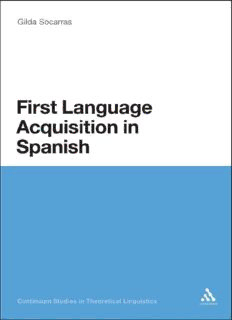
First Language Acquisition in Spanish : A Minimalist Approach to Nominal Agreement PDF
Preview First Language Acquisition in Spanish : A Minimalist Approach to Nominal Agreement
First Language Acquisition in Spanish Continuum Studies in Theoretical Linguistics Continuum Studies in Theoretical Linguistics publishes work at the forefront of present-day developments in the fi eld. The series is open to studies from all branches of theoretical linguistics and to the full range of theoretical frameworks. Titles in the series present original research that makes a new and signifi cant contribution and are aimed primarily at scholars in the fi eld, but are clear and accessible, making them useful also to students, to new researchers and to scholars in related disciplines. Series Editor: Siobhan Chapman, Reader in English, University of Liverpool, UK. Other titles in the series: Syntax in Functional Grammar, G. David Morley Agreement, Pronominal Clitics and Negation in Tamazight Berber, Hamid Ouali Deviational Syntactic Structures, Hans Götzsche A Neural Network Model of Lexical Organisation, Michael Fortescue The Syntax and Semantics of Discourse Markers, Miriam Urgelles-Coll First Language Acquisition in Spanish A Minimalist Approach to Nominal Agreement Gilda M. Socarrás Continuum Studies in Theoretical Linguistics Continuum International Publishing Group The Tower Building 80 Maiden Lane 11 York Road Suite 704 London SE1 7NX New York NY 10038 www.continuumbooks.com © Gilda M. Socarrás 2011 All rights reserved. No part of this publication may be reproduced or transmitted in any form or by any means, electronic or mechanical, including photocopying, recording, or any information storage or retrieval system, without prior permission in writing from the publishers. British Library Cataloguing-in-Publication Data A catalogue record for this book is available from the British Library. EISBN: 978-1-4411-90307 Library of Congress Cataloging-in-Publication Data A catalog record for this book is available from the Library of Congress. Typeset by Newgen Imaging Systems Pvt Ltd, Chennai, India Printed and bound in Great Britain To children who hold all the answers if we are willing to wait Contents Preface ix Acknowledgments xiii Chapter 1 Theoretical Foundations 1 Chapter 2 Experimental Methodology 9 Chapter 3 Gender Agreement 27 Chapter 4 Number Agreement 94 Chapter 5 Emergence of Determiner Phrases 151 Chapter 6 Conclusions 176 Appendices 186 Notes 207 Bibliography 214 Index 221 Preface The aim of this monograph is to present a cross-sectional experimental approach to the study of nominal agreement in Spanish child language with the purpose of complementing previous studies on this subject and in some instances fi lling the gaps left by them. In particular, this monograph focuses on the acquisition of gender (feminine/masculine) and number (singular/plural) agreement by three monolingual Spanish-speaking chil- dren under the age of three. The majority of studies on the acquisition of Spanish as a fi rst language are written in the context of the parametric approach, but I have chosen to adopt the framework of the Minimalist Program (MP) (Chomsky 1995, 2001) for two major reasons. First, the MP offers an elegant analysis of the acquisition of nominal agreement based on a process of matching or checking features (see Chapter 1). Second, it is hoped that the use of this approach will advance the research on Spanish acquisition to the theoretical developments of the past 15 years. Nonethe- less, the adoption of a new paradigm is not without its challenges, as will be discussed in the remainder of the book. The present monograph addresses formal aspects such as the availability of functional categories in child language, a vital component in the feature checking or matching process within the MP, as well as issues pertaining to the acquisition process, for example, how gender and number features are acquired. In particular, it explores whether children are able to estab- lish target-like agreement relations between nominals and their determin- ers (i.e., grammatical agreement), as well as agreement with respect to the actual utterance referent (i.e., semantic agreement), as illustrated in Example 1. Example 1 (a) La casa linda (Referent ‘one house’) ‘The (fem/sg) house (fem/sg) pretty (fem/sg)’ (b) *La casa linda (Referent ‘two houses’)
Description: